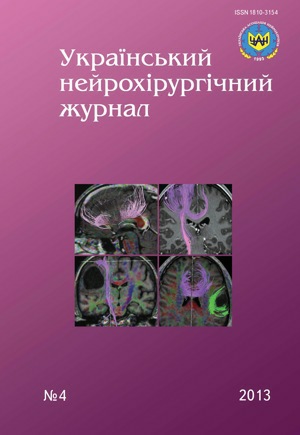Peculiarities of surgical treatment of craniofacial osteomas
DOI:
https://doi.org/10.25305/unj.55418Keywords:
osteomas, clinical signs, surgical treatmentAbstract
The purpose. To study features of craniofacial osteomas clinical flow and their surgical treatment.
Materials and methods. The results of examination and surgical treatment of 14 patients with craniofacial osteomas and 2 — with fibrous dysplasia were analyzed.
Results. In 9 patients wide craniotomy (bifrontal and frontotemporal approaches) was performed. At smaller tumor size, in particular, it’s intracranial part, we used subcranial approach (in 5 cases); at deeply located tumor — endoscopic endonasal approach was applied (in 2 cases).
Conclusions. Optimal surgical approaches were proposed taking into consideration features of craniofacial osteomas, in particular, their possible giant size and tissue hardness. The possibility to minimize surgical approach was proved.References
1. Bobrov VM. Dva nablyudeniya obshirnoy osteomy lobnoy pazukhi s prorastaniyem za yeye predely [Two observations of extensive osteoma in frontal sinus with invasion beyond]. Vestn Otorinolaringologii. 1999;5:56-7. Russian.
2. Kuzmenko YeYa, Dolzhenko SA, Kuz'menko DYe. Gigantskaya osteoma obeikh lobnykh pazukh, glaznitsy i pazukhi reshetchatoy kosti sleva [Giant osteoma both frontal sinuses, orbit and ethmoid sinus]. Zhurn vushnykh, nosovykh i horlovykh khvorob. 2002;1:66-7. Russian.
3. Barajas RF Jr, Perry A, Sughrue M, Aghi M, Cha S. Intracranial subdural osteoma: a rare benign tumor that can be differentiated from other calcified intracranial lesions utilizing MR imaging. J Neuroradiol. 2012 Oct;39(4):263-6. [CrossRef] [PubMed]
4. Choudhury AR, Haleem A, Tjan GT. Solitary intradural intracranial osteoma. Br J Neurosurg. 1995;9(4):557-9. [CrossRef] [PubMed]
5. Sugimoto K, Nakahara I, Nishikawa M, Tanaka M, Terashima T, Yanagihara H, Hayashi J. [Osteoma originating in the dura: a case report]. No Shinkei Geka. 2001 Oct;29(10):993-6. Japanese. [PubMed]
6. Fobe LP, Melo EC, Cannone LF, Fobe JL. [Surgery of frontal sinus osteoma]. Arq Neuropsiquiatr. 2002 Mar;60(1):101-5. Portuguese. [PubMed]
7. Savastano M, Guarda-Nardini L, Marioni G, Staffieri A. The bicoronal approach for the treatment of a large frontal sinus osteoma. A technical note Section of Otolaryngology, Department of Medical and Surgical Specialties, University of Padua, Padua, Italy. Am J Otolaryngol. 2007;28(6):427-9. [CrossRef]
8. Seiberling K, Floreani S, Robinson S, Wormald PJ. Endoscopic management of frontal sinus osteomas revisited. Am J Rhinol Allergy. 2009 May-Jun;23(3):331-6. [CrossRef] [PubMed]
9. Ledderose GJ, Betz CS, Stelter K, Leunig A. Surgical management of osteomas of the frontal recess and sinus: extending the limits of the endoscopic approach. Eur Arch Otorhinolaryngol. 2011 Apr;268(4):525-32. [CrossRef] [PubMed]
10. Béquignon E, Cardinne C, Lachiver X, Wagner I, Chabolle F, Baujat B. Craniofacial fibrous dysplasia surgery: a functional approach. Eur Ann Otorhinolaryngol Head Neck Dis. 2013 Sep;130(4):215-20. [CrossRef] [PubMed]
11. Lai WS, Lee JC. Fibrous dysplasia of the craniofacial bones. J Am Osteopath Assoc. 2013 Aug;113(8):641. [CrossRef] [PubMed]
12. Dias FL, Sa GM, Kligerman J, Nogueira J, Galvao ML, Lima RA. Prognostic factors and outcome in craniofacial surgery for malignant cutaneous tumors involving the anterior skull base. Arch Otolaryngol Head Neck Surg. 1997 Jul;123(7):738-42. [CrossRef] [PubMed]
Downloads
Published
How to Cite
Issue
Section
License
Copyright (c) 2015 Orest Palamar

This work is licensed under a Creative Commons Attribution 4.0 International License.
Ukrainian Neurosurgical Journal abides by the CREATIVE COMMONS copyright rights and permissions for open access journals.
Authors, who are published in this Journal, agree to the following conditions:
1. The authors reserve the right to authorship of the work and pass the first publication right of this work to the Journal under the terms of Creative Commons Attribution License, which allows others to freely distribute the published research with the obligatory reference to the authors of the original work and the first publication of the work in this Journal.
2. The authors have the right to conclude separate supplement agreements that relate to non-exclusive work distribution in the form of which it has been published by the Journal (for example, to upload the work to the online storage of the Journal or publish it as part of a monograph), provided that the reference to the first publication of the work in this Journal is included.









